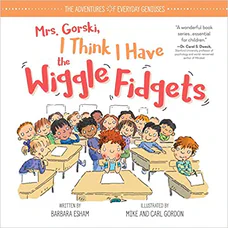Mrs. Gorski, I Think I Have the Wiggle Fidgets
An ADHD Book for Kids with Tips and Tricks to Help Them Stay Focused
Written by Barbara Esham
Illustrated by Mike and Carl Gordon
32 pages
•
Published 2018 (Little Pickle Press)

Recommended Age Range: 1st grade through 3rd grade.
Publisher's Summary:
David gets scolded a lot by his teacher, Mrs. Gorski, for not paying attention in class. He wants to pay attention but it is just so hard when an exciting idea pops into his head. And he usually can’t tell that he’s making a mistake until after he makes them. But after a particularly big mistake, David comes up with his own plan to tone down his wiggle fidgets.

Dr. Annie's Takeaways
Recommended for: This book destigmatizes the “wiggle fidgets” (recognizable as ADHD, but no diagnostic labels are used in the story), celebrates kids’ creativity, and empowers kids to brainstorm accommodations that might help them to better manage their symptoms. It’s a great read prior to a conversation with a child about school accommodations such as movement breaks and using a fidget toy.
Evidence-Based Practices:
Psychoeducation
Tone: Empowering, silly
Story Quality: This story is told in first person by David, a kid with the “wiggle fidgets,” who will be immediately recognizable to many kids with ADHD (although the label is not used in the story). The story models both the strengths (e.g., creativity) and challenges (e.g., distractibility) that often accompany ADHD in a way that feels loving and authentic. David starts out feeling hopeless and helpless–“The problem is, I’m not thinking about paying attention when I’m not paying attention. If I were thinking about paying attention when I’m not paying attention, I would definitely pay attention.” But after a long brainstorming session (“I’m great at that. Brainstorming is one of my strengths”), he comes up with a list of ideas that he thinks will help him manage his wiggle fidgets. The story has a number of silly, fun details that prevent it from being boring or dry (e.g., David does an experiment to see how much pressure his pudding cup could take before it explodes).
Illustrations: Fun ink and watercolor drawings with a lot of detail.
Representation: David is a White boy with the “wiggle fidgets.” No diagnostic labels are used in the story, but he has symptoms that align with ADHD, including distractibility, inattention, and impulsivity. David has White parents– a mom and a dad, who shares that he had the wiggle fidgets as a kid. David’s teacher, Mrs. Gorski is a White woman who also had the wiggle fidgets as a kid.
Psychological Practices: This book destigmatizes ADHD and empowers kids to brainstorm accommodations that might be helpful for them. The story lovingly portrays David as full of enthusiasm and ideas–strengths that accompany his challenges. It also reminds readers that kids with ADHD are usually doing the very best they can, and that it’s frustrating to them too when they act in ways that get them in trouble or that they later regret. At one point David bemoans, “I can always see the mistakes I make…after I make them. But before they’re mistakes, they just seem like great ideas. I wish I could stop myself.” In preparation for a family meeting with this teacher, David comes up with a plan to manage his wiggle fidgets in the classroom. His ideas include: attention cue cards to put on his desk (e.g., “Attention! Save that idea for later!”), a timer that counts down to breaks, a stress ball for fidgeting, and permission to move around periodically (e.g., by handing out papers). These are all decent ideas for helping a kid to focus in class, or while working on homework. They are not strategies that will address all of the symptoms of ADHD (e.g., organization, impulsivity), but they’re a good start.
Concerns: My primary concern is that the adults in David’s life are not helpful at all. In fact, David states as fact at the beginning of the book that his teacher doesn’t like him and that he bugs her, and while he is brainstorming ideas for his plan, he says, “I hope my parents and Mrs. Gorski will be proud of me for a change.” It’s really sad! However, many kids with the wiggle fidgets–diagnosed with ADHD or not–will relate to this. Kids with ADHD get many times more criticism over the day than kids without ADHD do, and many will relate to the humiliating feeling of being the kid the teacher calls out over and over again. In the end, after David has shared his plan to address his wiggle fidgets, his teacher and parents express pride, and his teacher is no longer frustrated with him. I love that David is his own hero. However, I can’t help but feel sad that the adults in his life didn’t help him to figure out this plan. A smaller, secondary concern is that David’s dad and Mrs. Gorski both share that they had the wiggle fidgets as kids, suggesting that it goes away once a kid becomes an adult. Although hyperactivity does tend to fade as kids become adults, ADHD is lifelong, and many adults with ADHD continue to benefit from supports and accommodations.
